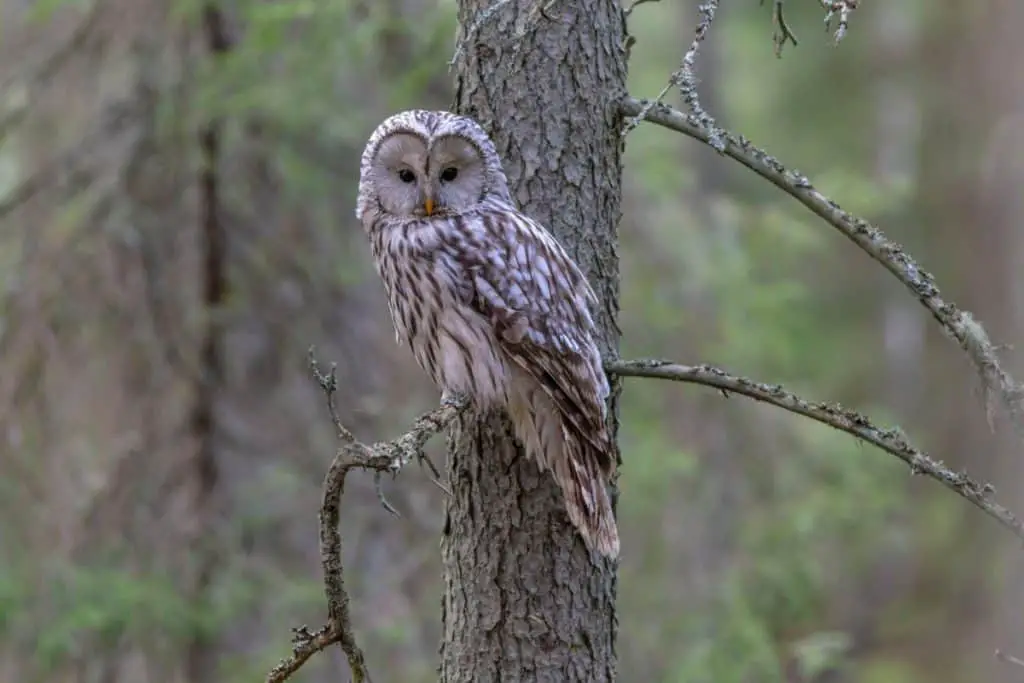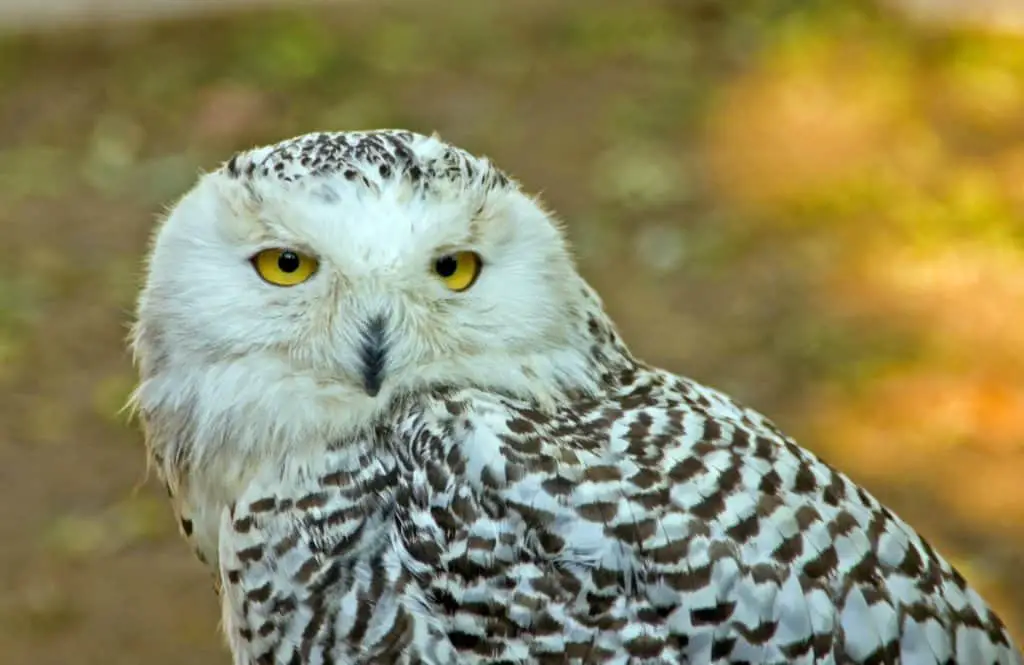
If you were looking for an answer to the question: “What colors are owls?” then you’ve come to the right article.
As, in this article, you’ll find the exact answer to this question, and also after you’ve read the answer to the main question then I’ll cover the answers to a few more closely related questions as well.
I hope you learn a lot from this article!
What colors are owls?
Owls usually have variegated coloration.
In other words, there are shades and tints of various colors present in owls.
While some individual owls can appear to be uniformly colored, this is very rare.
The precise colors vary widely, but most coloration has evolved to make owls blend into their environments.
By having varying shades of brown, gray, tan, red, and sometimes even bluish-black, owls are effectively camouflaged when perched in trees.
This provides them an advantage when hunting since their prey have a difficult time spotting them.
Check out the video below if you want to see the 10 most beautiful owls on earth.
What colors are most owls?
Most owls are not a single color, rather, their feathers contain shades and tints of a variety of colors.
The most common colors are brown, gray, and tan.
The coloration of an owl’s feathers is a function of evolutionary adaptation.
They have developed color patterns that allow them to blend into their environment.
For example, snowy owls, which are native to the Arctic, are primarily white which allows them to blend into the snowy landscape.
Immature snowy owls will appear to be almost entirely white, with only specks of dark brown or black, however, mature snowy owls tend to develop more pronounced dark tips on their feathers.
How many different colored owls are there?
Owls can have innumerable different color combinations.
Even among a single variety of owls, such as the barn owl, individual owls will have their own, unique coloring, ranging from very light to brown, and sometimes even gray.
Similarly, great horned owls all characteristically have combinations of brown, black, white (or cream), and gray, but some appear primarily brown whereas others appear primarily gray.
How many colors can an owl have?
An owl’s overall color or appearance is a function of the colors of the barbs on its feathers.
Just the wing of an owl (excluding the rest of its body) has nine different types of feathers, including remiges, coverts, alular quills, and axillaries.
In many cases, each type of feather will feature color variations of its own, and the afterfeather, or the downy lower part of the feather, is often much lighter in color than the tip.
So, it’s important to keep in mind that there is no limit to the number of colors, color combinations, and patterns that an owl can have.
Although each type of owl has certain characteristic colorings and patterns, each bird is unique.
What color are barn owls?
Barn owls characteristically have very pale bodies and white faces, with extraordinarily dark eyes.
Their light-colored breasts are often spotted with light browns, and the top side of their wings have gradations ranging from light buff to brown.
Their underwings are also very pale or white.
Do barn owls come in different colors?
While barn owls characteristically have pale, white bodies, some are much tanner or buff-colored.
Their wings can range in color from light cream, with buff tips, to tan and brown.
When viewed up close, barn owls often have small gray and white tufts.
What color are horned owls?
Horned owls tend to be mostly gray or brown, though their coloration is characteristically mottled with lighter and darker patches.
This allows them to blend in against the bark of trees.
Their “horns” are typically darker and their throats are lighter in color.

What color are great horned owls?
Great horned owls typically have rusty brown faces with a pronounced white patch above their breast.
Their body appears to be spotted or blotched with variations of gray and brown.
Individual great horned owls can range from being very light brown or gray, overall, to being very dark brown or sooty gray.
What are the colors of a snowy owl?
Snowy owls are native to the Arctic.
Like other owls, they have evolved colorations that allow them to blend into the landscape of their habitat.
They are primarily white, though the feathers on their wings, bellies, and crowns often develop brown or black spots, which gives those portions of their body alternating light and dark stripes.
This tends to be less pronounced in males than in females.
What are the colors of a barred owl?
Barred owls are native to North America.
Overall, they often appear to have a light base with dark stripes.
These stripes run horizontally across the bird’s neck and breast and vertically on its belly.
The individual feathers of a barred owl have alternating dark and light variegations, which gives the bird it’s spotted and “barred” appearance.
The darker areas range from brown to almost black, and the lighter areas can appear buff to almost white.
Typically, a range of such colors is found on the feathers of an individual bird.
What are the colors of a screech owl?
Screech owls have developed a color pattern that resembles the bark of a hickory or oak tree.
They are often primarily gray or rust-brown with a combination of darker spots and lighter stripes.
The eyes of the screech owl often appear yellow, particularly at night.
Are blue owls real?
Although owls tend to have “earthy” shades and tints, some owls have spots or stripes that appear blue.
Great horned owls, for instance, will sometimes develop bluish-black variegations.
Similarly, under certain lighting conditions, a snowy owl can appear to have a soft blue undertone.
Is there a rainbow owl?
Numerous images that purport to be of a rare “rainbow owl” can be found online, and some claim that its scientific name is “Strix mendacium”.
This, however, is a hoax.
The Latin word, “Strix” is used to denote an authentic genus of owls, which includes the spotted and barred owl.
However, the word “mendacium” means “liar,” and thus serves as a kind of easter egg, which betrays the fabricated nature of the alleged species.
Is there a purple owl?
While owls are sometimes depicted in illustrations, caricatures, and cartoons as purple, there are no actual purple owls.
Also, if you Google purple owl then you’ll likely find a photoshopped owl species that have been colored purple.
Is there a green owl?
There aren’t any green owl species that exist.
While an owl may appear to have a green tint when viewed under certain lighting conditions, no known owl species has authentical green colorations.

Does a pink owl exist?
While no species of owl present with pink feathers, albino owls of various species have red eyes.
Albinism is caused by a lack of melanin, which is what provides pigmentation within animals.
Because their feathers are not pigmented and their eyes are red, the feathers around the eyes can appear to be pink.
Check out the video below if you want to see what a great horned albino owl looks like.
What colors are the eyes of owls?
Many species of owl have stunning, large eyes.
They vary in color.
Snowy owls typically have black eyes, while those of screech owls are characteristically bright yellow.
Orange and brown eyes are common among many species as well.
What colors are the feathers of owls?
Most owl feathers feature a variety of shades of various warm, earthy colors.
The most common colors are various shades of brown, gray, tan, and white.
The variegated coloration of an owl’s feathers serves to camouflage the bird from its prey.
What color is an owl’s beak?
Owls typically have pale yellow, cream, or other light-colored beaks.
In the case of albino owls, their beaks like their feet and talons are pink.
Conclusion
In this article, you’ve read that owls often come with variegated colorations.
You’ve also read that it is very rare to find an owl with uniformly coloring.
Colors that are often found in owls are gray, tan, red, brown, and sometimes blueish black.
